If you want to slow down and escape city life in Norfolk, head to one of its charming villages. You can expect peace and quiet along with beautiful scenery but it won’t be boring. These Norfolk villages have plenty to offer.
Since you won’t have time to visit all the villages in Norfolk, we wanted to share a list of our top picks.
Be sure to also sign up for our email newsletter here to keep up to date with all the events around Norfolk.
Note: This post contains affiliate links. As an Amazon Associate, we earn from qualifying purchases. Please see disclosure for more information.
Best Villages in Norfolk to Visit
In this post, we will share more information about our favourite Norfolk villages along with other helpful information for you to plan your own visit.
Consider using these villages as your base for exploring more of Norfolk. Alternatively you could stay in Norwich city centre and take day trips to visit these villages.
Castle Acre
This village gets its name from the motte-and-bailey castle built in the 12th-century, one of the most impressive Norman earthworks in the country. Castle Acre Castle has bridges to make it easier to cross the ditches and stairs to help you reach the inner bailey. The views over the countryside will be worth the climb.

The main road into the Castle Acre village runs through the Bailey Gate, which is one of two stone gatehouses added to the settlement’s massive earthwork defences around 1200. Just a short walk from Castle Acre Castle and the Bailey Gate, you will find one of the best preserved monastic sites in the country, Castle Acre Priory.
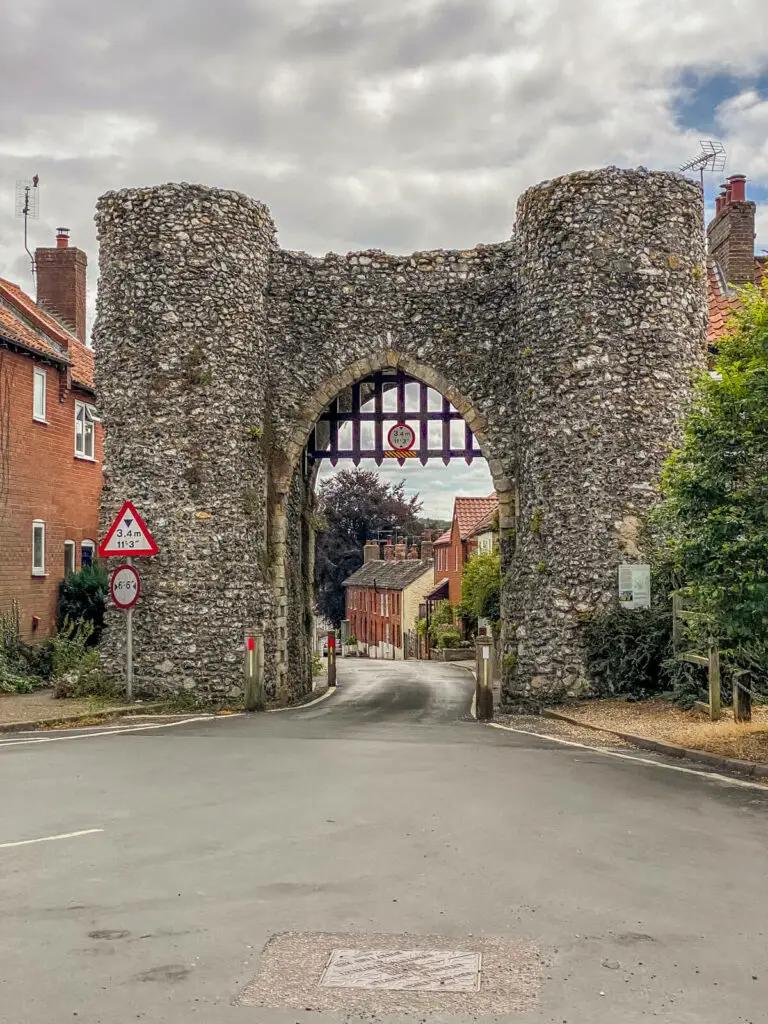
The parish church of St. James the Great is also worth a visit. Inside you can see the 15-century hexagonal font, rood screen base, wineglass pulpit, and misericords. In addition to these historic sites, the village also has charming flint houses, a green, tea shops, and a pub.
It’s easiest to drive to Castle Acre. There is free parking by the village green. Both the castle and priory also have car parks, although the one for the castle is tiny. If you are up for it, you can do a circular walk to see the area, get detailed directions here.
Great Massingham
Great Massingham is one of those picture-perfect English villages with a green, a medieval church, flint cottages, and several ponds with ducks. Some of these ponds began as fish ponds for an 11th century Augustinian Abbey.
St Mary’s Church has historically been more than just a place for worship. It was the place for non-religious meetings and the porch, added around 1300, was used as a school room. England’s first Prime Minister Sir Robert Walpole is believed to have been educated here.
Inside the church, you will want to see the 14th century font, the coats of arms painted high on the clerestory walls, the unused door to the rood loft in the north wall of the chancel, and the 15th century painted glass in the south windows of the chancel.
One of the reasons we keep going back to Great Massingham is the Dabbling Duck pub. It’s one of our favourite places to eat (and drink) in Norfolk.
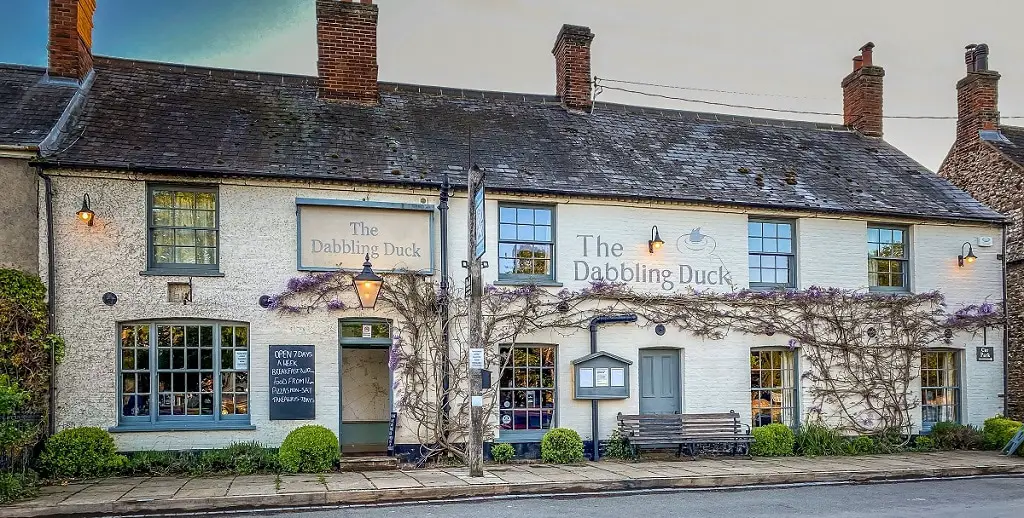
Great Massingham does not have good public transport connections so it is best to drive. If you are visiting the Dabbling Duck, they have parking in the back.
Binham
Binham is a small village that was mentioned in the Domesday Book. A 15th century market cross stands atop a high plinth in the village green. You will see a large number of historic houses, many Grade II-listed, in the area around the green.
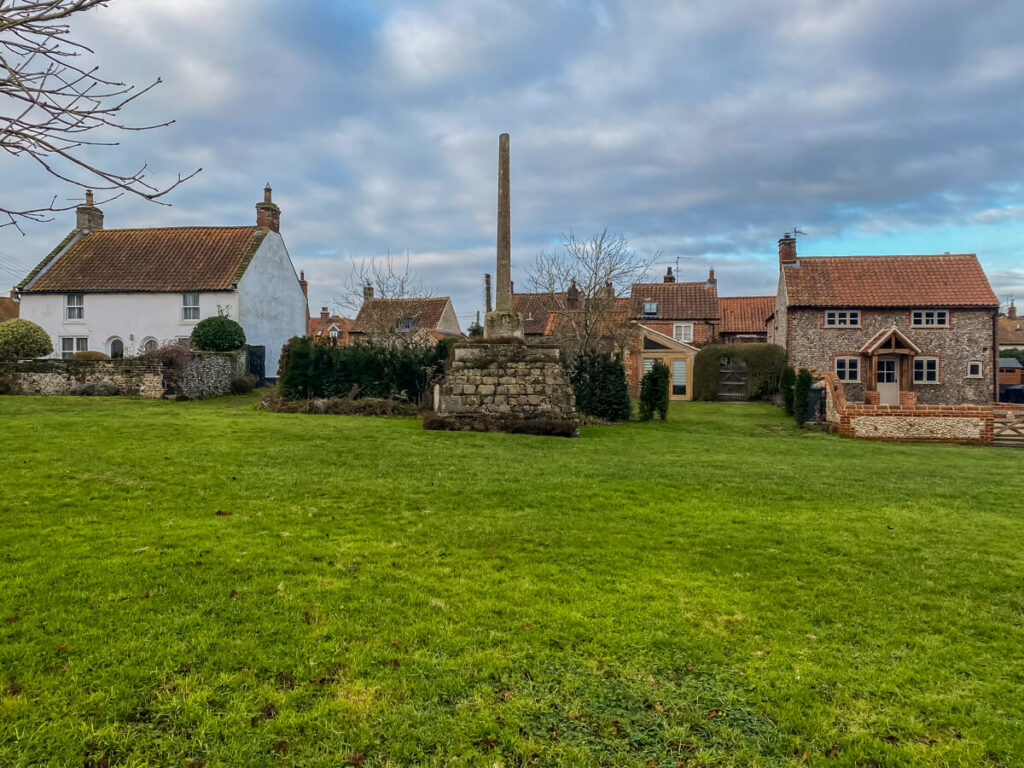
Just outside the village, is one of Norfolk’s best hidden gems, Binham Priory. It has been a continuous place of worship for more than 800 years!
The Binham Priory may have been closed and partially dismantled during the dissolution of the monasteries, but the nave continued on as the Binham parish church. It is free to visit the Priory ruins and go inside the parish church.
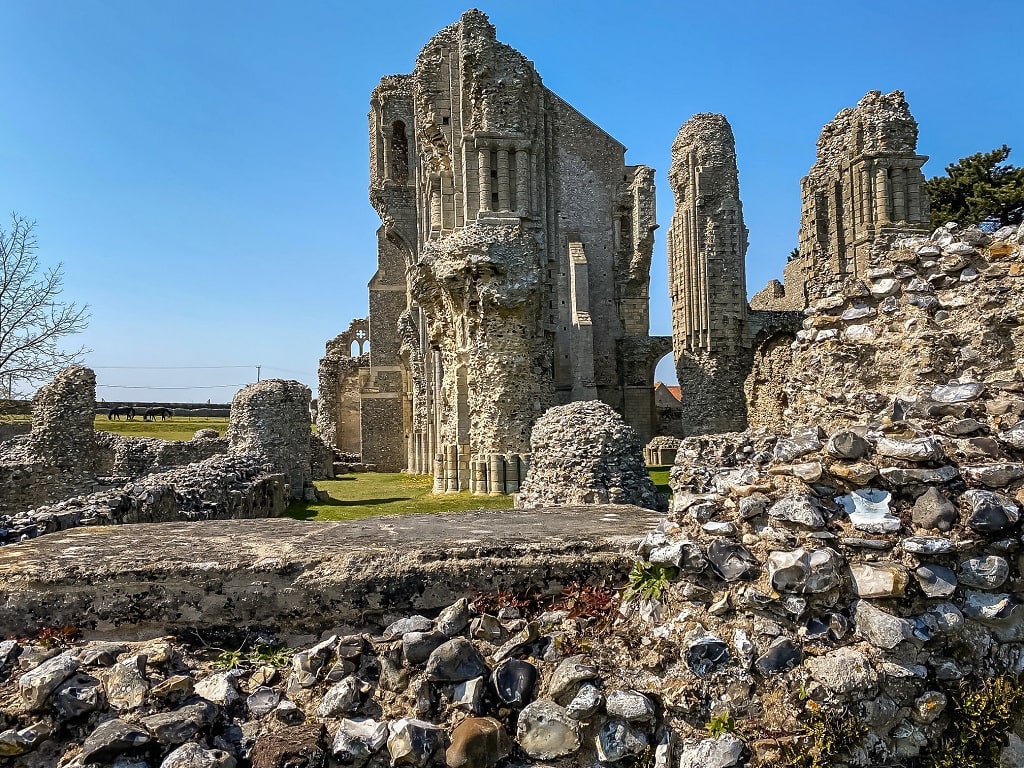
If you fancy a pint or some food during your visit to Binham, stop in at The Chequers Inn on High Street not too far from the Priory. It’s a traditional pub, dating to the 17th century, with outdoor seating during the warmer months.
It’s best to drive to Binham as there is no train station and limited bus service. There is a large gravelled car park by the Binham Village Memorial Hall.
Cley-Next-the-Sea
During the middle ages, Cley-next-the-Sea was one of the busiest ports in Europe and a haven for smugglers. It was more important than the towns of King’s Lynn or Great Yarmouth until the river channel began to silt up. Now the village is best known for its nature reserve and windmill.
Norfolk Wildlife Trust’s Cley Marshes is their oldest nature reserve. In 2012, NWT was able to purchase more land and link the Cley Marshes Reserve with Salthouse, creating a large coastal reserve that is one of the country’s most popular birdwatching sites, attracting more than 110,000 visitors annually.
The Cley Windmill is one of the most photographed in Norfolk. It was built in the early 19th century and was converted into a holiday home around 1921. In 1983, it opened as a guesthouse and is now also a popular wedding venue.
Cley-next-the-sea is also home to St. Margaret’s Church which dates to the 13th century. Other popular spots include the smokehouse, bookshop, deli, and the George and the Dragon pub.
While the village doesn’t have a train station, there is a stop on the Coasthopper bus. Alternatively, you can also drive. There is a free car park by the Village Hall.
Blakeney
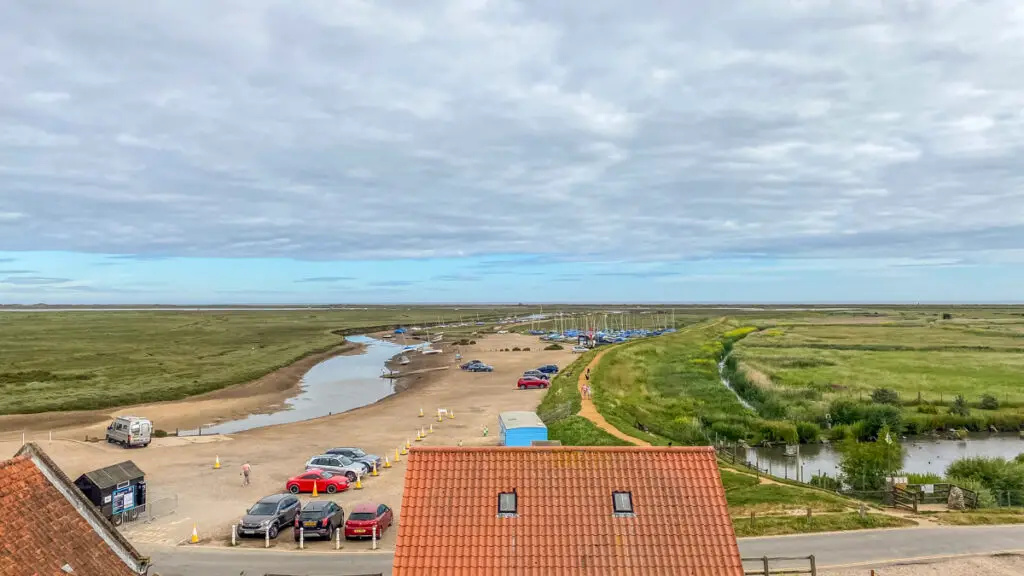
This charming village used to be a busy medieval commercial port known for piracy and smuggling until the estuary began to silt up. The silting turned the area into marshes, sand banks, and creeks, but the village remained.
It has pretty flint cottages where the fisherman used to live along with cafes, restaurants, pubs, shops, and art galleries. You will also want to check out the Blakeney Guildhall with its 15th century brick vaulted undercroft. On the edge of the village, you can find St. Nicholas Church with its two towers.
Blakeney is in an Area of Outstanding Natural Beauty and the Blakeney National Nature Reserve, a National Trust property. The quay is the starting point for many lovely walks, but if you want to see the seals (and birds) at Blakeney Point, you will need to catch a boat from Morston Quay.
Blakeney is on the Coasthopper bus line, but from Norwich it is probably easier to drive. There are three car parks available. The one by the quay is free for National Trust members, but you will need your membership card. The Village Hall car park is free for everyone.
Read about more things to do in Blakeney.
Mundesley
This coastal village is home to one of the best beaches in Norfolk. It’s sandy and a good spot for swimming when the tide is out. While this Blue Flag beach is narrow, it is backed by a promenade lined with colourful beach huts.
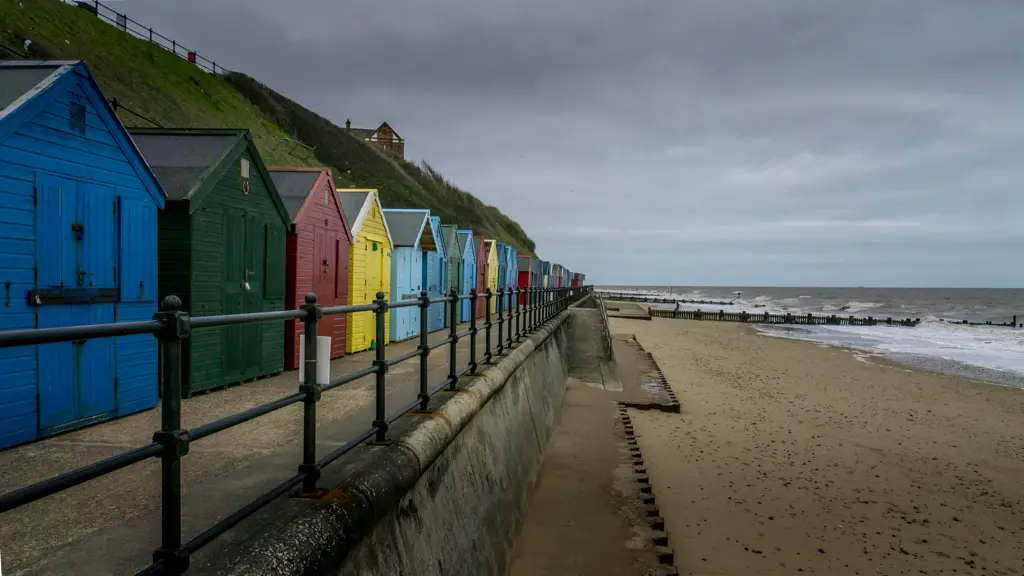
The clifftop gardens above the beach is home to the smallest maritime museum in the world. There is also a memorial to the Bomb Disposal teams that cleared landmines from Norfolk beaches after the Second World War.
Mundesley doesn’t have a railway station but it is on the Coasthopper bus line. From Norwich, it is easiest to drive. There is a pay and display car park across the street from the Maritime Museum.
Little Walsingham
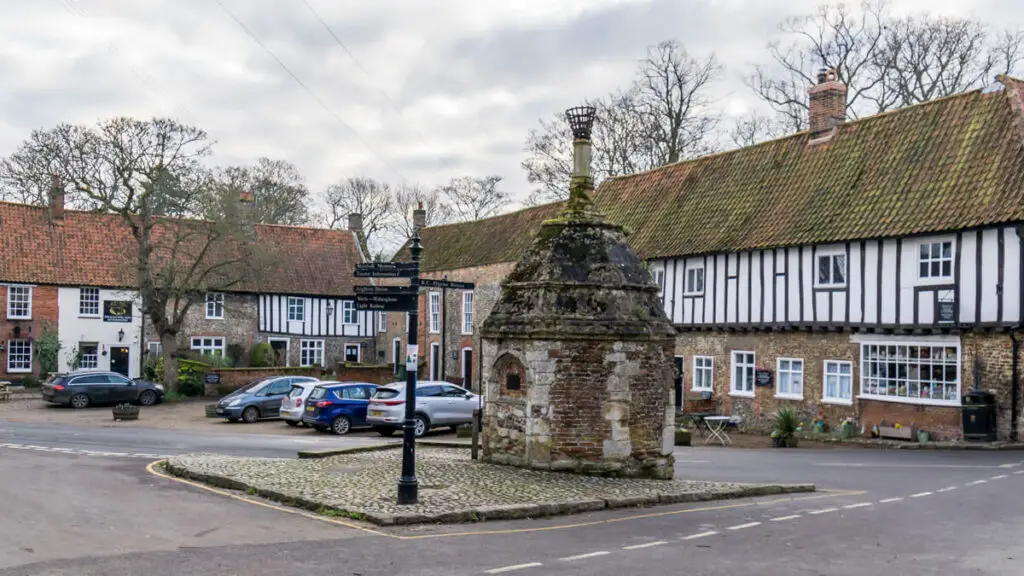
Little Walsingham is one of the holiest places in England. It has been a pilgrimage site since the 11th century when Richeldis de Faverches, a Saxon noblewoman, had visions of the Virgin Mary who requested that a replica of the Holy House at Nazareth be built at Walsingham. Hundreds of thousands of pilgrims visit this small village in Norfolk each year.
You can visit the ruins of Walsingham Abbey which was destroyed during the Dissolution of the Monasteries. It’s one of the best places to see snowdrops in Norfolk during the winter. Admission is free for Historic Houses members. Read our guide to the Walsingham snowdrops.
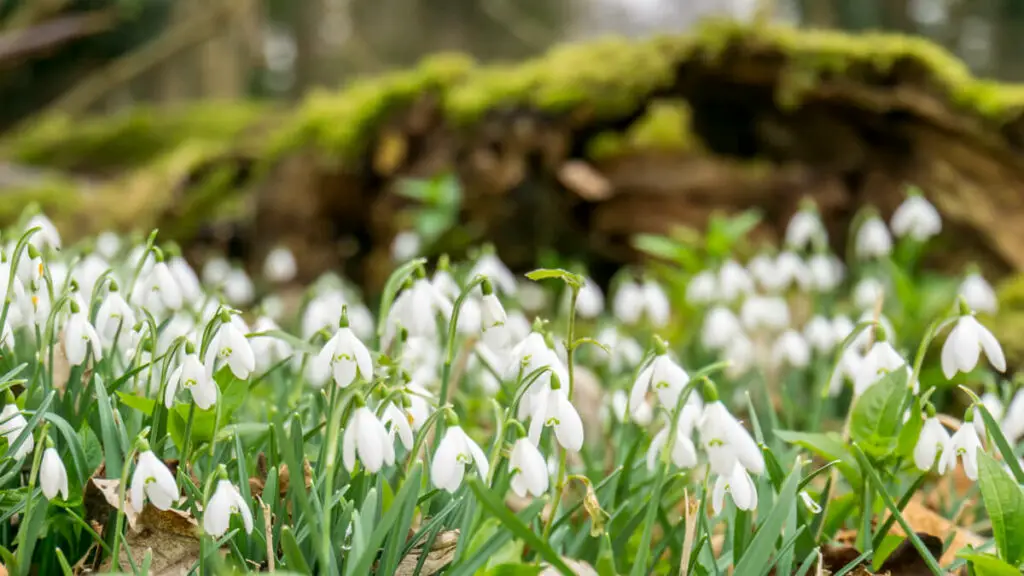
To see a replica of the Holy House, you have to go to the Anglican Shrine of Our Lady of Walsingham which was built in the early 20th century. At the Anglican Chapel, you can also try the holy water or even attend a service.
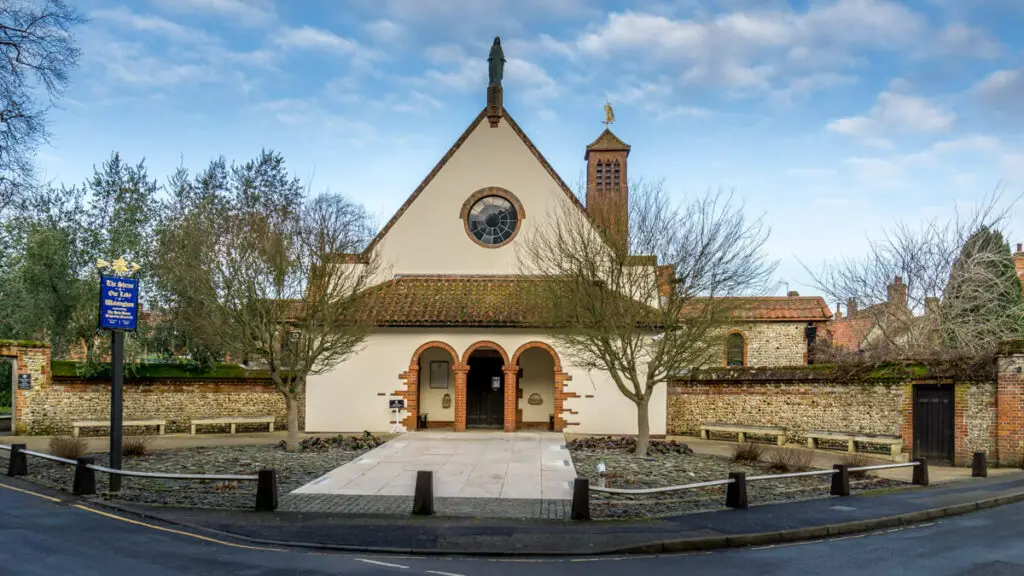
A mile away in the village of Great Walsingham, you can visit the Roman Catholic Baslica aka The Slipper Chapel. It was the final “station” on the Walsingham pilgrimage route where pilgrims would take off their shoes to walk the final “Holy Mile” barefoot.
Also, you can ride on the smallest public railway in the world. The famous Wells & Walsingham Light Railway runs between Walsingham and Wells-next-the-Sea. Keep in mind it closes during the winter for maintenance.
The best way to get to Little Walsingham is to drive. There is a car park close to Walsingham Abbey.
Burnham Market
Three of the original seven Burnham villages – Burnham Sutton, Burnham Ulph, and Burnham Westgate – merged to create Burnham Market, making it the largest one. The Burnham name comes from the fact that they are all close to the mouth of the River Burn.
Burnham Market is one of the most expensive places to live in Norfolk and is a popular spot for second home owners. With its open green and charming flint buildings, it has earned the nickname “Chelsea-on-sea.”
The village has a mix of local independent shops including a bookshop, butcher, antique shops, hardware shop, fish shop, deli’s, beauty salons, and art galleries. It also has an excellent selection of upscale places to eat including Socius, Hoste Arms, and No Twenty9.
While you can take a bus to Burnham Market, it will be easier to drive. There is the North St pay and display car park that is off of Foundry Place.
Caister-on-Sea
Just north of Great Yarmouth, you will find the village of Caister-on-Sea. It has a large sandy beach with picturesque dunes and views of the Scroby Sands Wind Farm. There are no restrictions on dogs at this beach so it is popular with dog walkers.
Right by the beach, you can visit the Caister Lifeboat Experience. It’s perfect for families. They let you climb aboard a vintage lifeboat, dress up in a lifeboat waterproof kit, and learn about some of the life saving rescues.
About a 15-minute walk from the beach, there are the ruins of the Caister Roman Town which was built around 200 AD and occupied until the end of the 4th century, when the Romans left Britain. It was not discovered until excavations in 1951, and now is an English Heritage property that is free to visit.
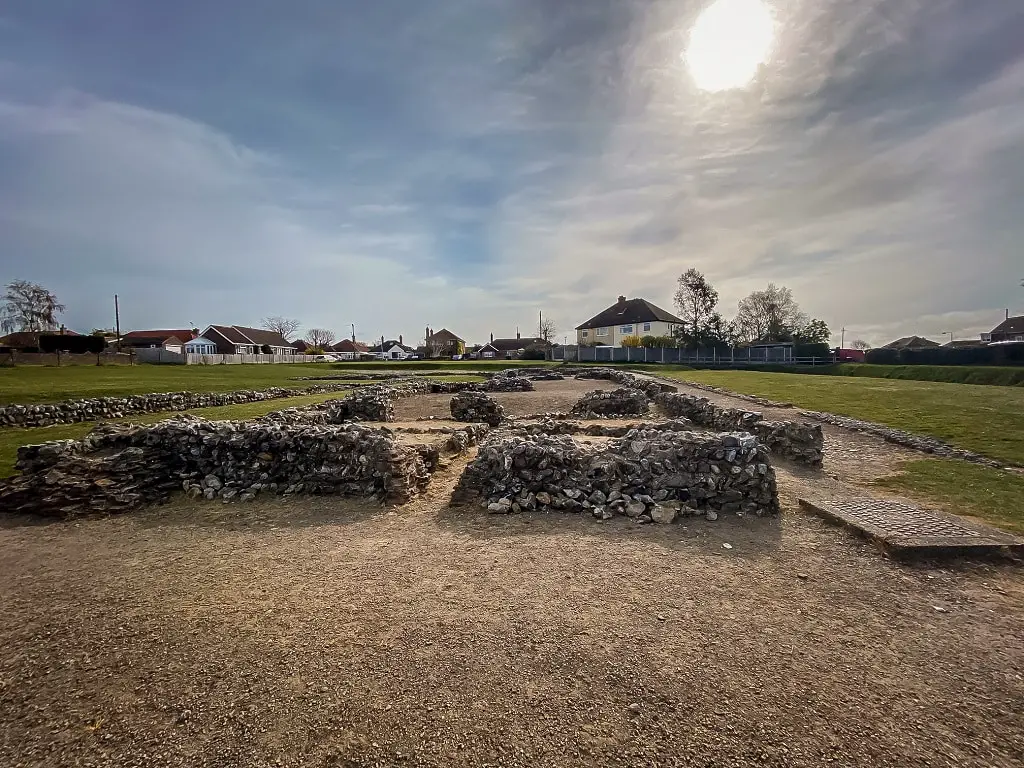
It’s probably easiest to drive to Caister-on-Sea and use the large pay and display car park by the beach. Alternatively, if you want to use public transport there are bus options. Caister does not have a train station.
Wroxham & Hoveton
Wroxham is affectionately known as the ‘Capital of the Norfolk Broads’ and Hoveton sits just on the other side of the River Bure. Together they make for a fun family day out where you can take a walk along the river, watch the boats go by (or hire your own), and check out other popular attractions.
If you want to get out on the water there are several boat hire companies in the area or you can take a Broads Boat Tour. It’s the best way to explore the National Park.
The village also has several attractions for rail enthusiasts including steam trains. You can ride the Bure Valley Railway to Aylsham or check out Miniature Worlds, the largest indoor modelling attraction in the UK. There is also the Barton Miniature Railway and Mystleigh Indoor 00 Gauge Scenic Model Railway and Railway Art Gallery.
Wroxham and Hoveton is one of the few places in the Norfolk Broads that is easily accessible by train. The Bittern Line that runs from Norwich to Sheringham stops at the Hoveton and Wroxham station (HXM) which is a short walk from most attractions. You can catch a train from Norwich and be there in less than 20 minutes.
If you want to drive, it takes about 20 minutes from Norwich. Don’t be surprised if there is traffic, the main road (A1151) seems to be a bit of a bottleneck.
Learn more about things to do in Wroxham and Hoveton here.
Horning
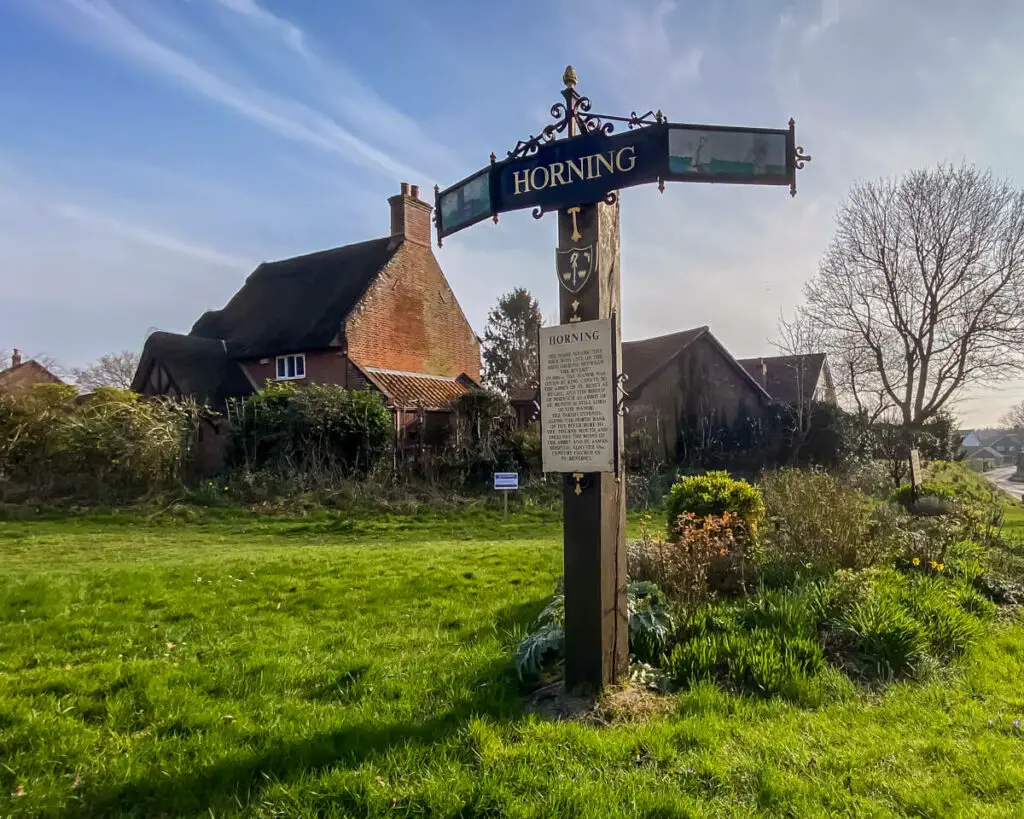
Known as the “Jewel of the Broads”, the waterside village of Horning one of the prettiest in the Norfolk Broads. Take a walk along Lower Street and you will find some of the best waterside pubs along with thatched houses, gift shops, and more. There is also space for picnicking.
Just outside the village you can find the church of St Benedict that dates from around 1220. The earliest parts of the building are the priest’s door in the Chancel and the pillars along the wall on the north side of the Nave. You can also see the lead-lined 14th century Baptismal font, interesting carvings on the Choir Stalls, and four Coats of Arms relating to the church’s history.
While you can take a bus to Horning, your best option is to drive. There is a car park by Swan Green and also one by the village hall.
You can also travel to Horning by boat. There are some free moorings but they do fill up especially during the summer months.
Get more information on things to do in Horning here.
Ranworth
Ranworth is a lovely Broadland village that is adjacent to Malthouse and Ranworth Broads. Ranworth Broad is closed to boats as it is a nature reserve, but you can enjoy the wildlife there from the Floating Wildlife Centre (closed during the winter).
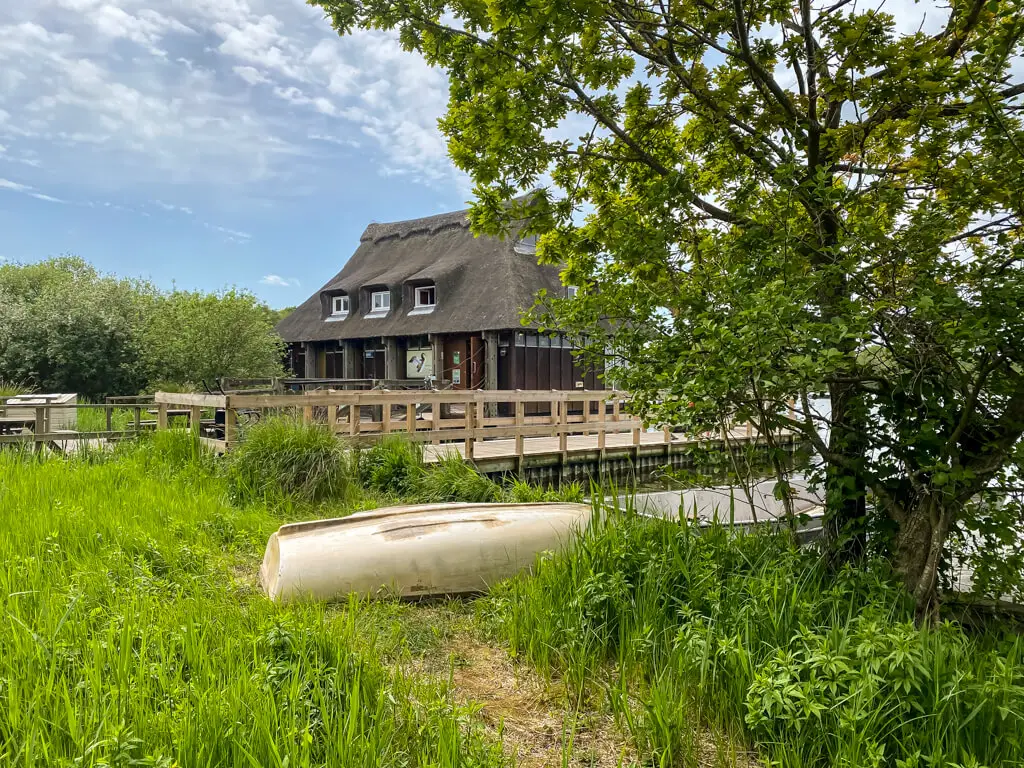
Another must see in Ranworth is St. Helen’s Church, also known as the “Cathedral of the Broads,” which dates back to the 14th and 15th centuries. Inside you can see one of the finest medieval rood screens in England and a 15th century illuminated manuscript (kept in a case for protection).
You can climb the 89 steps and 2 ladders inside the church tower to the roof. It’s hard work and a little tight at times, but worth it for the views!
When you need a break from exploring Ranworth, head to the popular Maltsters Pub. When the weather is nice, their garden is the place to be. They also have a car park. UPDATE: The Maltsters permanently closed in December 2023.
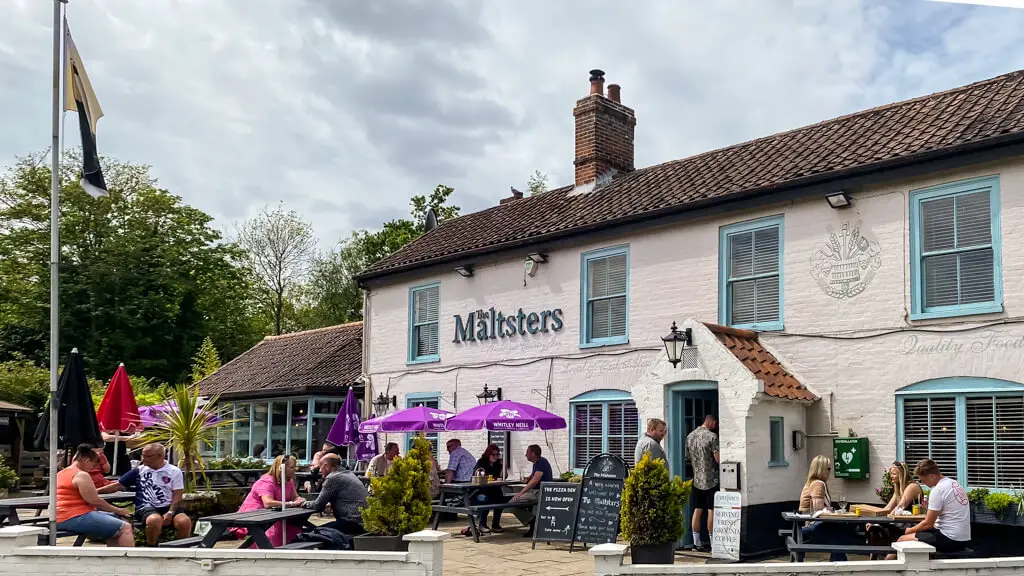
If you are traveling to Ranworth by boat, there are some free moorings at Ranworth Staithe. It does tend to fill up during the peak season.
Find out more about the things to do in Ranworth.
Other Villages in Norfolk
This is NOT a complete list of Norfolk villages. We just wanted to highlight our favourite villages to visit in Norfolk to help you prioritize. Other villages in Norfolk like Coltishall, Holkham, Oxborough, Mulbarton, Acle, Caister St. Edmund, Happisburgh, Marsham, and Hemsby also have a lot to offer visitors.
Which Norfolk village are you going to visit next?
Disclosure: This post contains affiliate links. This means we will receive a small commission for some purchases made using links in our blog with no additional cost to you. Please be assured we would not promote any product unless we believe that our readers will also benefit. The commission does not influence the editorial content of this site.

